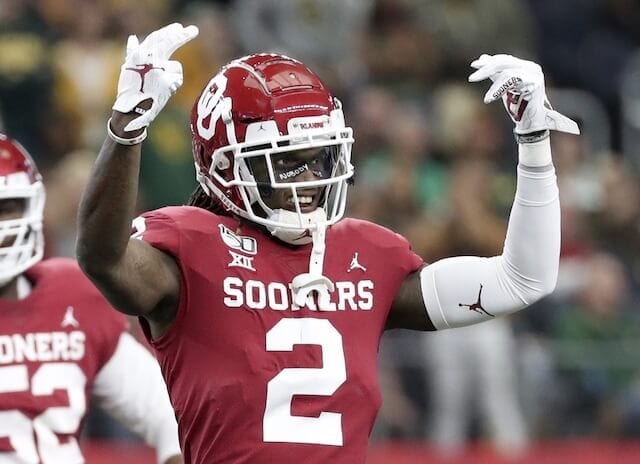There’s no other way to put it: Oklahoma’s CeeDee Lamb is a freak. If there’s a receiver in this draft who looks the part of a No. 1 receiver, there’s no doubt that it’s Lamb — one of three receivers battling it out for the title of being the best receiver in the 2020 NFL Draft.
The funny thing about Lamb is that he exposes a few of the biggest issues one faces when evaluating a handful of receivers against one another. For starters, not every receiver is asked to do the same things — either at the college or pro level — and so how do you compare an underneath receiver with an over-the-top guy? Beyond that, you’re dealing with a wide spectrum of quarterback abilities, defensive back competition and play-callers. Simply put, this isn’t an exact science.
But enough about the difficulties, let’s dive into CeeDee Lamb…
Height: 6’2″
Weight: 198 lbs
40-yard-dash: 4.50
Bench Press: 11
Vertical jump: 34.5
Broad jump: 124
College stats: 40 games, 173 catches, 3,292 yards, 32 touchdowns (plus 1 rushing touchdown and 1 passing toucdown), 54 punt returns (8.8 yards per return)
Imagine what it was like to be Lamb in college. As a freshman, you get Baker Mayfield’s Heisman Trophy season. As a sophomore, it’s a new quarterback (Kyler Murray), but another Heisman. And then, as a junior, it’s yet another quarterback (Jalen Hurts) — albeit one who came in with National Championship experience.
But what do you do with all that? Not only was he playing in the all-offense, no-defense Big 12 — but he also played with two Heisman Trophy winners. On the flip side, during his junior season, he played with a quarterback that — at least on tape — wasn’t all that great. Still, his best season came this last year, when he caught 62 passes for 1,327 yards and 14 touchdowns.
As I hinted at above, one of the challenges for evaluating Lamb compared to guys like Jerry Jeudy and Henry Ruggs III is the varying levels of competition. While Jeudy and Lamb were facing NFL caliber defensive backs on a regular basis, Lamb wasn’t. And yet, a dive into the game logs will assuage those fears pretty quickly.
In the biggest games, Lamb showed up.
As a freshman in the Rose Bowl (CFP Semifinal) against Georgia, Lamb caught six passes for 66 yards and threw for a touchdown. As a sophomore, his two biggest games were the Big 12 Championship against Texas and then the Orange Bowl (CFP Semifinal) against Alabama. In those two games, Lamb went for 6-167-1 and 8-109-1. Then, as a junior, once again he got to play in the Big 12 Championship Game (against Baylor) and the Peach Bowl (CFP Semifinal against LSU). His lines: 8-173-0, 4-119-0.
Against Georgia, Texas, Alabama, Baylor and LSU he averaged 6.4 catches for 126.8 yards while adding three touchdowns. So yes, the Big 12 on average isn’t great, but the stage never scared Lamb one bit.
The reason I start there is because when you watch the tape there isn’t a whole lot to say. He’s fantastic on contested catches, he’s tough through contact — even seeking it out at times and his ability to run with the ball in his hands is the best of any receiver in the class.
Of course, there are some questions about his explosiveness after a pretty disappointing combine performance in which his 40-time and jumping numbers were all well below his competitors’. Then again, you’ve seen the tape — does he look slow? Un-explosive? Of course not.
Verdict: PICK
The Las Vegas Raiders’ wide receiver room isn’t terrible — especially when you include the talent they have at tight end — but what it needs is someone to come in and be a true No. 1 receiver. They need someone to attract double teams and still win. They need someone to make big plays after the catch and create offense where it doesn’t already exist.
On the surface, Lamb answers all of those questions best. He can play both inside or outside and he’ll bring an explosiveness to the room the day he steps foot inside of the facility. That said, I think Lamb is the biggest boom-or-bust guy of the three. There’s a world in which he can’t get off press coverage, he isn’t big enough to be a true No. 1 receiver and his 4.5-speed looks slower against elite coverage. But while that’s scary to consider, the upside makes it all worth it.


